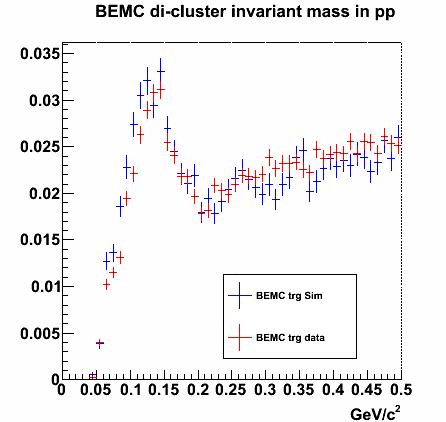- xuanli's home page
- Posts
- 2015
- 2014
- 2013
- December (4)
- November (2)
- October (6)
- September (4)
- August (6)
- July (4)
- June (4)
- May (4)
- April (3)
- March (15)
- February (6)
- January (5)
- 2012
- December (3)
- November (10)
- October (9)
- September (4)
- August (5)
- July (11)
- June (3)
- May (1)
- April (1)
- March (1)
- January (2)
- 2011
- December (3)
- October (4)
- September (3)
- August (3)
- July (2)
- June (6)
- May (13)
- April (7)
- March (10)
- February (2)
- January (1)
- 2010
- 2009
- My blog
- Post new blog entry
- All blogs
FMS triggered p+p simulation comparison with data
Comparation between FMS triggered data and simulation in p+p
(1) FMS Selections
1, in data, using FMS triggered data, selec at least one reconstructed pi0 in the FMS with pt > 2.0GeV/c. There 27 pp runs.
2, in simulation, applying FMS acceptance cuts for pi0 decayed photons, and requiring the pi0 with pt > 2.0GeV/c. Using the latest generated p+p FMS filtered simualtion.
(2) BBC requirement
East BBC charge sum non-zero and west BBC charge sum non-zero.
(3) Results
Using STAR library SL11b, and the tower threshold 250MeV. The red distributions are using simulation and the blue distributions are using data.
1, EEMC
.gif)
Figure1, EEMC tower multiplicity shown in the left and tower energy (normalized by events) shown in the right above 250MeV.
.gif)
Figure2, EEMC zvertex distribution (left) and the single cluster energy (right).

Figure3, EEMC cluster pairs mass.
2, BEMC
.gif)
Figure4, BEMC tower multiplicity shown in the left and tower energy (normalized by events) shown in the right above 250MeV.
.gif)
Figure 5, BEMC zvertex distribution (left) and the single cluster energy (right).

Figure 6, BEMC cluster pair invariant mass.
Conclusion:
The differences between simulation and data are smaller than previous.
- xuanli's blog
- Login or register to post comments
